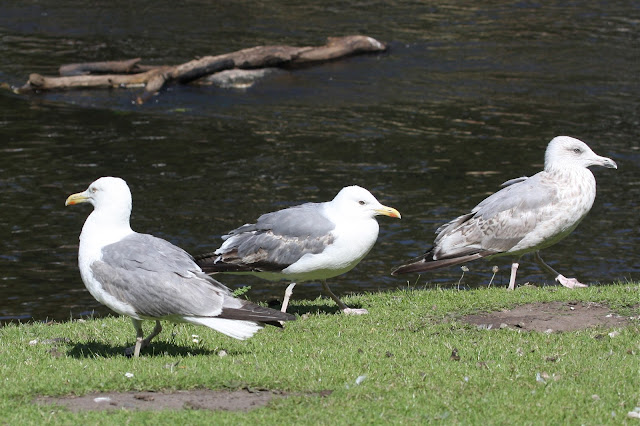 |
| Comparison shot showing different mantle tones of argenteus Herring Gull (left), graellsii Lesser Black-backed Gull (right) and Herring x LBBG hybrid (centre). This is Bird 1 of 2. |
A extremely good morning of gulling at Musselburgh with
Little Gull,
Kittiwake and juvenile
Mediterranean Gull (another!) at the Esk mouth and two hybrid
Herring x Lesser Black-backed Gulls along the grassy banks of the Esk. All those Lothian year-tick waders on the scrapes (
Wood Sandpipers et al.) will have to wait for another time... Never mind, grilling these two
argentatus x
fuscus hybrids at close range made up for all the distant views I have had over the last few months. These hybrids closely resemble
Yellow-legged Gulls, which are so rare in Lothian that every candidate has to scrutinised closely – in my experience every candidate so far has turned out to be a hybrid (see
here,
here,
here,
here and
here). In addition, I now believe that this bird that I photographed at Musselburgh in 2010 and was the subject of
this BirdForum thread was also a Herring x Lesser Black-backed Gull hybrid.
Here is today's first bird a sub-adult advanced third summer type plumage, perhaps, or retarded fourth summer...
 |
| Hybrid Herring x LBBG at Musselburgh 4 Aug 2013 (Bird 1): note mid grey upper tone and greyish pink leg colour. Primary projection is exaggerated by excessive wear of white margin on tertials - extent of wear can be seen by exposed rachis on furthest wing. Note band across P5 on nearest wing - narrow particularly on inner margin. Eye ring red. |
 |
| Hybrid Herring x LBBG at Musselburgh 4 Aug 2013 (Bird 1): mid grey upper tone and greyish pink leg colour.
Extensive black on underside of P10. Note excessive wear of what would have been a broad white margin on secondaries and
tertials - extent of wear can be seen by exposed rachis. Eye ring red. |
 |
| Hybrid Herring x LBBG at Musselburgh 4 Aug 2013 (Bird 1): newly grown P1–3 show fresher colour but still overall mid grey tone. Greater signs of immaturity than expected when wings spread. P10–P5 on left wing show extent of black in outer primaries - this presumably will reduce as this moult continues and bird ages. Note band across P5 on nearest wing - narrow particularly on inner
margin. Note excessive wear of white margin on
inner secondaries and tertials. |
 |
Hybrid Herring x LBBG at Musselburgh 4 Aug 2013 (Bird 1): a view of the pattern of black on underside of primaries
|
Here is today's second bird, a sub-adult third summer type plumage, perhaps... Note that this bird is identical (apart from a slight difference to bill tip coloration) to the third cycle hybrid of known Lesser Black-backed x Herring parentage shown in plates 307–309 of Adriaens et al. (2012) Hybrid gulls in Belgium – an update
British Birds 105, 530–542, which is quite easy to find online.
 |
| Hybrid Herring x LBBG at Musselburgh 4 Aug 2013 (Bird 2): note mid grey upper tone and pinkish leg colour. Note band across P5 on nearest wing - narrow particularly on inner
margin. Eye ring reddish. |
 |
| Hybrid Herring x LBBG at Musselburgh 4 Aug 2013 (Bird 2): note mid grey
upper tone and pinkish leg colour. Although the bird is missing P6–7 on both wings the subterminal band pattern on both P5 can be made out here and it is complete but narrow on the inner margin.Note also the extent of black in the tail. |
 |
| Hybrid Herring x LBBG at Musselburgh 4 Aug 2013 (Bird 2): P6 is growing on left wing. Extensive black/brown in the tail and extensive brown secondaries. |
 |
| Hybrid Herring x LBBG at Musselburgh 4 Aug 2013 (Bird 2): Not only is this bird almost identical to the one in Adriaens et al (2012) but it is almost identical to the one I photographed nearby in 2010 and was discussed in BirdForum here. |
Finally, here are both birds together, with a Herring Gull. As I was photographing the second bird the first flew up river and checked me out to see if there was any more croissant going!...

































